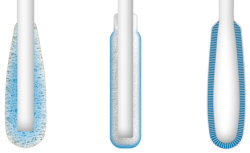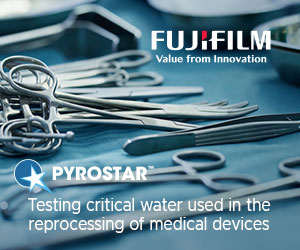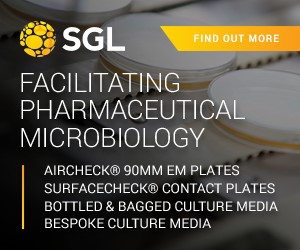Testing the Water wi...
This product is no l...
8th February 2010 Content supplied by:
Flocked Swabs Proven Superior in Sample Uptake and Release

In 1893, William Thomas Councilman wrote an article for the American Journal of Medical Science outlining the process of making microbiology transport swabs. This process was described as that of wrapping cotton pledgets around the end of wires, enclosing these wires in test tubes and sterilizing them in a hot air sterilizer. In the 100 years since Councilman's original publication, little innovation had been seen in specimen collection swabs. The only technological improvement of note was a shift in the type of fiber used. Cotton fibers, known to contain inhibitory fatty acids, and Calcium Alginate fibers, which can inhibit PCR, were replaced by non toxic synthetic fibers, such as Rayon and Polyester (Dacron).
The technology for making wrapped fiber swabs is widely available and relatively inexpensive. However, for microbiology purposes, where the sample is precious and often very small in quantity, the fiber wrapped design is fundamentally and seriously flawed. The problem lies in the wrapping of over a mile of fiber around the applicator creating a deep and hydrophilic central core, which while absorbing sample very well, does not allow for adequate sample release. In a best-case-scenario example, which includes perfect collection, vigorous vortexing of the sample, and flawless plating and streaking, a 30 to 40% sample recovery rate may be seen. This rate could drop to as low as 10-20% if all conditions are not ideal. Having access to the entire sample is crucial as it increases the sensitivity of a test and likely the speed at which infectious disease agents may be detected.
Understanding sample entrapment and flow dynamics were fundamental drivers in innovation for microbiology sample collection. As early as the 1990's, many companies began research and development of alternative devices to traditional fiber wrapped swabs. Two designs emerged from this research. The first design was developed in 1992, and it consisted of a polyurethane foam tipped swab, which has an open cell structure at its exposed surface, for which Becton Dickinson held its patent until recently. Foam swabs, it was suggested, displayed less sample entrapment and a notable improvement in flow dynamics. Foam tipped swabs are hydrophobic in nature, which allows for a sample release notably better than the traditional fiber wrapped swabs. However, the same hydrophobic property which makes the foam tipped swab release so well also represents the key drawback of polyurethane foam tipped swabs which absorb significantly less volume, as much as three times less than traditional fiber wrapped swabs.
Concluding that foam tipped swabs, because of their low sample absorption, were only marginally better than their fiber wrapped predecessors, Copan Diagnostics continue its research and development in search of an alternative that would increase both specimen uptake and sample release. In the early 2000's, Copan began researching flocking technology and developed the second alternative to traditional swabs, the first Flocked Swabs. Recognizing that high sample absorption and then 100% release are the essential goals for a breakthrough in swab design, and understanding that open cell foam swabs only address part of the equation, Copan invented Flocked Swabs for applications in the pre-analytical phase of microbiology. This new invention maximized both of the essential objectives of specimen collection and transport: specimen uptake and release.
The Flocked Swab comprises of a solid plastic applicator, which can be molded into various anatomical shapes, ensuring patient comfort without compromising the quality of the device. Glue is applied to the applicator tip and then tens of thousands of short nylon strands are sprayed (or flocked) onto the tip. The perpendicular fibers absorb liquid samples by the capillary action created by the surface tension between the nylon strands. Unlike traditional fiber swabs, Flocked Swabs have no inside core to entrap the sample. Copan's Flocked Swab technology yields a sample volume uptake that far exceeds traditional fiber swabs and is at least three times greater than open cell foam swabs. Then, once in contact with preservation media, culture plate, microscope slide or assay cartridge, almost all of the collected sample rapidly and spontaneously drains or rinses from the Flocked Swab.
The superior fluid dynamics of Flocked Swabs in comparison with open cell foam swabs and fiber wrapped swabs is without question and can be demonstrated by simple experiments comparing the volume of liquid absorbed by rolling or dipping each swab type in liquid. An example of such experiments can be viewed online by clicking this link: www.copanusa.com/info/.
In the dipping experiment a regular size open cell foam swab absorbed as little as 25µl compared to a regular size Flocked Swab, which absorbed 142µl, more than five times greater volume. Similar findings on open cell foam swabs were reported at the 12th Annual Meeting of the European Society for Clinical Virology (ESCV) in Istanbul in September 2009: Download pdf file.
In this report, open cell foam swabs were shown to absorb on average 28.6µl of liquid compared to 142.2µl with Copan Flocked Swabs. For swabs that have a similar geometry and application, this finding would reinforce the notion that foam swabs are hydrophobic. Additionally, in the CLSI M40-A standard Quality Control of Microbiological Transport Systems, special consideration is made of the low sample absorption volume of open cell foam swabs. To ensure sufficient loading, this standard recommends dosing hydrophobic foam swabs with double strength organism inocula. Even though foam swabs may have a high efficiency in sample release, like Flocked Swabs do, collecting considerably less sample could have dramatic consequences in terms of test sensitivity and positive detection rate. In fact in the previously mentioned study, presented at ESCV, Flocked Swabs increased the limits of detection of all Influenza A and B rapid antigen tests compared to foam swabs and the intensity of the reaction lines were reported to be better and easier to read with Copan Flocked Swab samples. In a different presentation at ESCV, Copan Flocked Swabs and open cell foam swabs were dosed with Influenza A and B virus, held for 2 hrs, and then processed by tissue culture and PCR. With Flocked Swab samples, more infected cells could be seen by fluorescent antibody staining and PCR detection was improved by 5 cycles compared with foam swab samples. This data was based upon regular sized swabs; however in the case of minitips, which are most commonly used as Nasopharyngeal swabs for influenza testing, the amount of sample volume absorbed by foam swabs is more alarming as can be seen in the comparison table and translates into as little as 21µL of sample being transferred if vortexed into the test or assay tube.
Type of Swab | Average Sample Absorption Volume (Immersion for 5 seconds) | Average Sample Release Volume Vortex 5 seconds | Average Sample Release Volume
Roll Plate Technique* |
Regular Fiber Wrapped (Rayon/Dacron) | 105µL | 35µL (or 33%) | 19µL (or 18%) |
| Regular Foam | 36µL | 33µL (or 92%) | 20µL (or 56%) |
| Regular Flocked | 131µL | 127µL (or 97%) | 105µL (or 80%) |
| Minitip Fiber Wrapped (Rayon/Dacron) | 45µL | 45µL | 11µL (or 25%) |
| Minitip Foam | 23µL | 21µL (or 90%) | 18µL (or 79%) |
| Minitip Flocked | 94µL | 92µL (or 98%) | 76µL (or 81%) |
*Procedures described in CLSI M40-A Standard. As shown in this chart, fiber wrapped swabs, open cell foam swabs and Flocked Swabs are compared by rolling or dipping each swab type in liquid and analyzing the volume, in µL, of liquid absorbed and released. The results of the experiments suggests that even though foam swabs may have a high efficiency in sample release, as Flocked Swabs do, they collect considerably less sample.
Copan has dedicated many years of research to innovate and develop optimum devices that are both comfortable for the patient and that drive the mechanics and fluid dynamics to deliver the maximum amount of sample into the assay. Copan´s Flocked Swabs combine an anatomically designed collection system that significantly improves the quality and sensitivity of clinical diagnostics.
Tags:
Date Published: 8th February 2010
Testing the Water with Lab
This product is no longer






